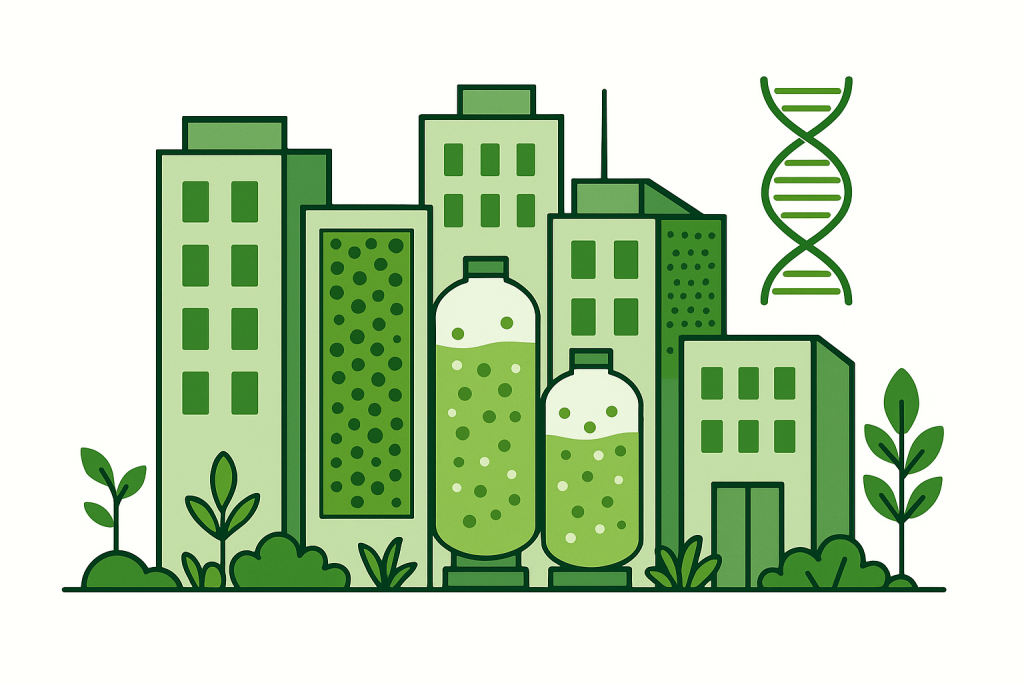The future city won’t just consume energy and materials—it will produce them, sustainably and locally.
The City as a Living Factory
Urban infrastructure is evolving from static to symbiotic.
For centuries, cities have been engines of consumption—importing food, energy, and goods while exporting waste. That model is changing. Across the world, urban planners and architects are beginning to integrate biofoundries, fermentation hubs, and local biomanufacturing labs directly into city design.
The result is a new urban archetype: the bio-block—a district where living systems and human systems co-produce materials, energy, and food. Instead of smokestacks, these blocks host vertical bioreactors. Instead of warehouses, they contain fermentation gardens that transform waste into resource.
The industrial city is giving way to the regenerative city.
From Factories to Biofoundries
What used to be mechanical is now biological.
Traditional factories depend on resource-heavy processes: mining, refining, transporting, and assembling. Biofoundries operate differently. They use living cells as programmable factories—capable of producing everything from biodegradable plastics to proteins and pigments.
By placing these facilities within urban centers, cities reduce shipping, carbon emissions, and reliance on fragile global supply chains. Imagine:
- Neighborhood-scale bioreactors producing packaging and construction materials.
- Municipal wastewater plants doubling as carbon-capture and algae production sites.
- Local breweries retrofitted as fermentation hubs creating biofuels or food proteins.
Biology becomes infrastructure. And infrastructure becomes alive.
The Urban Regeneration Model
Cities are ecosystems waiting to be rediscovered.
In nature, waste is always food. Urban bio-production applies that same principle, closing loops between food, energy, and materials.
For example:
- Organic waste from restaurants feeds microbial fermentation systems.
- CO₂ emissions from transit networks supply algae bioreactors.
- Water treatment plants recover nutrients for local agriculture.
Each cycle feeds another, creating self-sustaining metabolic networks. These aren’t symbolic sustainability projects—they’re functional systems designed for economic and ecological performance.
When planned correctly, bio-blocks can transform industrial dead zones into living urban ecosystems—places that clean, produce, and adapt.
Architecture Meets Synthetic Biology
Buildings are no longer static—they can grow, heal, and evolve.
Architects are exploring how biological materials can replace traditional concrete and steel in urban design. Engineered mycelium (fungal networks) can form lightweight, self-repairing walls. Bio-cement produced by microbes can bind sand or rubble into solid structures. Even facades made from living algae can generate oxygen and filter air.
The convergence of synthetic biology and architectural design is creating a new discipline: bio-urbanism. Here, cities don’t fight nature—they collaborate with it. Buildings act like trees, infrastructure behaves like soil, and neighborhoods become adaptive, resilient organisms.
Economic and Environmental Payoffs
Local production doesn’t just help the planet—it strengthens communities.
Integrating bio-manufacturing into cities builds resilience by reducing dependence on distant suppliers. It also creates new forms of employment in fields like biotechnology, environmental engineering, and sustainable materials design.
Economically, bio-blocks align with circular principles:
- Local inputs: Cities use their own waste streams as resources.
- Short supply chains: Production and consumption happen side by side.
- Continuous innovation: Biofoundries can pivot production with software updates instead of retooling equipment.
The environmental payoff is equally strong. Bio-based manufacturing consumes less energy, emits less carbon, and produces materials that can biodegrade or return safely to the environment.
Education and the Civic Role of Biology
Bio-literacy must become part of urban literacy.
For parents, educators, and city leaders, the rise of bio-production ecosystems means rethinking what it means to live and learn in a city. Schools can partner with local bio-labs to teach students how biology can solve real-world urban challenges—from food security to waste reduction.
Bio-literacy isn’t about turning everyone into scientists—it’s about helping citizens understand how living technologies shape the environments they inhabit. The more people engage with these systems, the safer, smarter, and more sustainable they become.
Governance and Ethics in Living Cities
When cities become living systems, oversight must evolve too.
Urban bio-production introduces new ethical questions. Who owns the genetic designs used in public infrastructure? How do we prevent misuse or ecological imbalance?
Cities will need bio-governance frameworks that balance innovation with safety. This means transparency, public consultation, and shared responsibility for managing living technologies. Just as zoning laws shaped the industrial era, bio-regulatory design will shape the next one.
Conclusion: Designing for Life
The 20th century built cities for efficiency. The 21st will build them for life.
From city blocks to bio-blocks, the evolution of urban design reflects a deeper shift: we’re learning to see cities as part of nature’s metabolism, not apart from it.
When biology becomes the foundation of urban infrastructure, cities can finally behave like the ecosystems they depend on—productive, regenerative, and alive.
The city of the future won’t be a machine. It will be a living organism—and we’ll all be part of its design.


